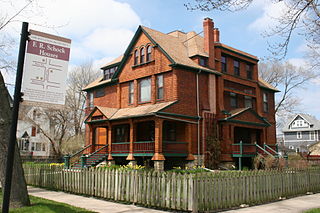The year 1948 in architecture involved some significant events.

The Civic Opera House, also called Lyric Opera House is an opera house located at 20 North Wacker Drive in Chicago. The Civic's main performance space, named for Ardis Krainik, seats 3,563, making it the second-largest opera auditorium in North America, after the Metropolitan Opera House. Built for the Chicago Civic Opera, today it is the permanent home of the Lyric Opera of Chicago. It is part of a complex with a 45-story office tower and two 22-story wings, known as the Civic Opera Building that opened November 4, 1929 and features Art Deco details.

The Chicago Defender Building is the former Jewish synagogue that housed the Chicago Defender from 1920 until 1960. It was designated a Chicago Landmark on September 9, 1998. The building is in the Black Metropolis-Bronzeville District in the Douglas community area of Chicago, Illinois at 3435 S. Indiana Ave. It was designed by Henry L. Newhouse.

The Chicago Avenue Pumping Station is a historic district contributing property in the Old Chicago Water Tower District landmark district. It is located on Michigan Avenue along the Magnificent Mile shopping district in the Near North Side community area of Chicago, Illinois. It is on the east side of Michigan Avenue opposite the Chicago Water Tower.
The Longwood Drive District is a historic district in Chicago, Illinois. The houses along Longwood Drive in the Beverly neighborhood were built beginning in 1873 by various architects. Longwood was named for a long copse of trees that ran along the lee side of the hill where the rest of Beverly is located. The area was designated a Chicago Landmark on November 13, 1981. The Longwood Drive has a mixture of different styles of architecture, such as Italianate, Carpenter Gothic, Queen Anne, Shingle, Prairie School, and Renaissance Revival.

Old Edgebrook is a historic district and neighborhood in the Forest Glen community area of Chicago, Illinois, United States.

The Seven Houses on Lake Shore Drive District is a historic district in Chicago, Illinois, United States. The district was built between 1889 and 1917 by various architects including Benjamin Marshall, Holabird & Roche, Howard Van Doren Shaw, and McKim, Mead & White. It was designated a Chicago Landmark on June 28, 1989.

The William and Jessie M. Adams House is a Prairie school style house located at 9326 South Pleasant Avenue in Chicago, Illinois.

The Beeson House and Coach House is a Queen Anne style house located at 5801 West Midway Park in Chicago, Illinois, United States. The house was built in 1892 by Fredrick R. Schock for Fredrick Beeson. It was designated a Chicago Landmark on January 20, 1999.

The Colvin House is a house at 5940 North Sheridan Road in Chicago, Illinois, United States. The house was built in 1909 by George W. Maher. It was designated a Chicago Landmark on October 5, 1994. This residence was built for Edwin M. Colvin, his wife Clara and their four children. Colvin moved to Chicago in 1885 and worked in the printing industry, ultimately becoming an executive with F.W. Hall Printing Company.
The Eliel House is a house at 4122 South Ellis Avenue in Chicago, Illinois, United States. The house was built in 1886 by Adler & Sullivan for Mathilde Eliel. It was designated a Chicago Landmark on October 2, 1991.

The Rath House is an architecturally significant house located at 2703 West Logan Boulevard in the Logan Square neighborhood of Chicago, Illinois, United States. It was built in 1907 by the architect George W. Maher for John Rath, the owner of the Rath Cooperage Company, one of the largest barrel-making concerns in the country. The house was designated a Chicago Landmark on December 1, 1993.

The Schlect House is a Shingle Style house at 5804 West Race Avenue in Chicago, Illinois, United States. The house was built in 1887 by Fredrick R. Schlock for his aunt Catherine Schlect. It was designated a Chicago Landmark on January 20, 1999.

The Soldiers' Home is an Italianate style house in Chicago, Illinois, United States. The Soldiers' House is located at 739 E. 35th St. The house was built in a series of phases from 1864 to 1923 by William W. Boyington and other various architects. It was designated a Chicago Landmark on April 16, 1996. The Soldiers' Home is the last surviving building with exact association to the Civil War. During the war the home served as a hospital for injured soldiers. After the war it became a home for disabled Union Army Veterans.
The Hitchcock House is a house at 5704 W. Ohio Street in the Austin neighborhood of Chicago, Illinois, United States. The house was built in 1871 for Charles Hitchcock. It was designated a Chicago Landmark on July 7, 1992.

The Ryerson & Burnham Libraries are the art and architecture research collection of the Art Institute of Chicago. The libraries cover all periods with extensive holdings in the areas of 18th-, 19th- and 20th-century architecture and 19th-century painting, prints, drawings, and decorative arts. A variety of materials important to scholarly research includes architects' diaries, correspondence, job files, photographs, sketchbooks, scrapbooks, articles, transcripts, and personal papers.

The Glen Mitchell House, also known as Mitchell House, was a unique design in Dodge City at the time it was built, as it was modeled using Asian influences which were considerably different from the surrounding conventionally styled homes. The home in the Organic Architecture style was designed by architect Bruce Goff when Goff was practicing architecture in Kansas from 1964–1968 and built by Don Stein and Leo Jantz both of Dodge City, Kansas, United States. The house located at 1905 Burr Parkway, Dodge City, Kansas was designed in 1968 for Dr. Glen Mitchell, a practicing dentist and accomplished musician, and with the use of colors, textures and natural materials and landscaping the architect achieved a home that was in "harmony with its landscape".

















